Grasshoppers are jumping insects that can be found in a wide variety of habitats. They occur in large numbers in semi-arid areas, grasslands, and lowland tropical forests. These insects are able to change their characteristics to form swarms, which include color and behavior.
There are around eleven thousand grasshopper species in the world with more being discovered. We have listed the forty most common grasshoppers in Texas from the most common to least common. Continue reading to find out more.
The most common grasshoppers you will encounter in Texas include:
Table of Contents
1. Differential Grasshopper
The Differential grasshopper (Melanoplus differentialis) is found throughout Northern Mexico and the Central United States. It is considered a pest that grows to 50mm in females and 37mm in males.

These grasshoppers are brown or green in color, the color darkens with age. You may see a pattern of inverted chevrons on the hind femur and a yellow tibia with black spikes. Their antennae are yellow or a red/yellow color.
They can be found throughout most of the United States, but not in the northwest. They are usually encountered in grasslands and heavily weeded areas, as well as urban areas. They do not migrate but will travel miles to find food.
2. Obscure Bird Grasshopper

This grasshopper (Schistocerca obscura) is referred to as a subspecies of Salutacea and is not easy to tell apart from other members of the family.
These grasshoppers are common in the open woodlands and fields in the southern United States including Florida, Texas, New Mexico, Arizona, and Pennsylvania.
These short-horned grasshoppers are often seen visiting flowers, especially goldenrods. Males can grow to 45mm and females to 65mm. They are green with gray to red/brown fore wings and green, yellow or white knees.
3. Green-striped Grasshopper

The green striped grasshoppers (Chortophaga viridifasciata) are common throughout North America. They prefer moist habitats and are often found near hay meadows, sunny grass areas, roadsides, and pastures.
These grasshoppers can grow to 38mm for females and 30mm for males. Males are brown, while females tend to be green. Male green-striped grasshoppers have thicker legs and heads when compared to females, while females have thicker and longer abdomens.
They have yellow wings with smokey coloration at the tips and a green to brown stripe close to the front wing border.
4. American Bird Grasshopper

The American bird grasshopper (Schistocerca americana) is native to North America and they occasionally have localized outbreaks. These are large grasshoppers with males growing to 4.5cm and females to 5.5cm in length.
They are yellow to brown in color with pale wings that have brown spots. Nymphs can range in color from yellow or red to green with black pattern marketings. The black pattern is influenced by temperature.
5. Short-winged Green Grasshopper

The short-winged green grasshopper (Dichromorpha viridis) is a medium-sized short-horned grasshopper that can grow to 26.5mm in body length. They are mostly green with a dorsally slanted face.
You may encounter these grasshoppers in grass that is less than knee length, fields, roadsides, pastures, wooded areas, on the edge of ponds, and near lakes.
6. Admirable Grasshopper

The admiral grasshopper (Syrbula admirabilis) is usually found in dry grass with males growing to 31mm and females to 49mm. They have a slanted face and long, slender hind legs. The threat-like antennae on the males have an expanded tip.
The females are green to brown in color, while males appear more black. The fore wings have a wavy pattern on them, which is visible when folded. While the males are good flyers, the females tend to leap in order to escape predators.
7. Aztec Spur-throated Grasshopper

The Aztec spur-throated grasshopper (Aidemona azteca) belongs to the Acrididae family with nymphs being brightly colored in reds, blacks, and yellows. They are excellent jumpers. Adults tend to blend in with their environment, as their bright colors fade with age.
These grasshoppers are found in the mountains of Trans-Pecos, Texas.
8. Ponderous Spur-throat Grasshopper

The Ponderous spur throated grasshopper (Melanoplus ponderosus) is a member of the short-horned grasshopper family and is the most common grasshopper you will encounter in North America. It is known for the damage it causes to crops.
These grasshoppers are yellow, green, or orange with shades of red or brown. In some cases, the body is beautifully colored with spots, bands, and blotches. They have short antennae.
This grasshopper is a common visitor to open meadows and fields. Their diet is made up of grass.
9. Spotted Bird Grasshopper

The male spotted bird grasshopper (Schistocerca lineata) can grow to 50mm with females growing to 69mm. These yellow, brown, or green colored grasshoppers are darker on the top side with a pale stripe down the back of their head and pronotum.
There is usually a row of black dots on the abdomen. They have long antennas. They are widely distributed and common in Texas where you may encounter them in sunny and sandy areas, including riparian areas, ditch banks, and shrubland.
10. Two-striped Mermiria

The two-striped mermiria (Mermiria bivittata) is a short-horned grasshopper with long wings and a sword-shaped antenna. They have slanted faces and a pale brown to yellow body. There is a dark brown to black colored stripe from the back of the eye to the fore wings.
Nymphs usually start appearing from mid-June with adults being encountered from July through to September. The female is larger than the male, growing to 51mm. Males only grow to 38mm.
11. Gray Bird Grasshopper
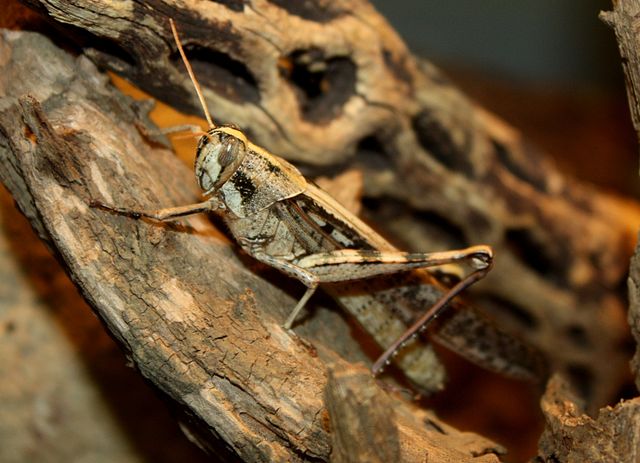
The gray bird grasshopper (Schistocerca nitens) is also known as the vagrant grasshopper and is closely related to the desert locust. They live in varying habitats from woodlands to deserts and lower elevation mountains, often seen among shrubs and trees.
These large grasshoppers can grow to seven centimeters and are gray to brown. They are known pests that can be encountered throughout the year in Texas.
12. Pallid-winged Grasshopper

This grasshopper (Trimerotropis pallidipennis) is encountered mostly in the summer months. They are not easy to see, as their coloration helps them blend into their surroundings of gravel and dry river beds. The males grow to 35mm, while females can grow to 45mm.
Sometimes this species is known to develop damaging numbers with one outbreak in Arizona lasting more than one year. These gray to gray-brown grasshoppers have dark banding on their fore wings. The hind wings are narrow and long in a pale yellow, green, or purple.
The pallid winged grasshopper is more common in deserts and grasslands where there is plenty of shrubs and bare ground.
13. Plains Lubber Grasshopper

The plains lubber grasshopper (Brachystola magna) is a large grasshopper that is red/brown with black dots on the outer wings. There are color variations with some being greener than others. These grasshoppers have small wings and are not able to fly.
Their antenna is brown/blue and has a red coloration on their legs with purple tarsi. They are not known to cause serious damage to crops. They can grow to 55mm in body length.
In 2012, Texas experienced an outbreak of plains lubber grasshoppers in Edwards, McCulloch, Schleicher, Menard, Runnels, and Tom Green counties. They prefer scrublands and grasslands and are often encountered in weedy vegetation from early summer through to fall.
14. Eastern Lubber Grasshopper

This grasshopper (Romalea microptera) is native to the southeastern and south-central United States, known for its size and unique color. They can reach up to 8cm in length. They prefer open pine forests, weedy vegetation, weedy fields, and sewers.
The Eastern lubber grasshopper is not able to fly with wings that are only half the length of their abdomen. Their bright coloration acts as a defense, along with their foul-smelling and tasting secretion, which they secret from their thorax if they are disturbed, along with loud hissing.
15. Rainbow Grasshopper

The rainbow grasshopper (Dactylotum bicolor), also known as the painted grasshopper is native to the United States, first described in 1843. Females are larger than males, growing to 35mm, while males grow to around 20mm.
They are black grasshoppers with red and yellow markings, pale green wing pads, and pale green prothorax. There are spines on the hind legs. They do not have wings and are unable to fly.
They are commonly encountered in desert grasslands, alfalfa fields, thinly vegetated areas, and short grass prairies.
16. Wrinkled Grasshopper
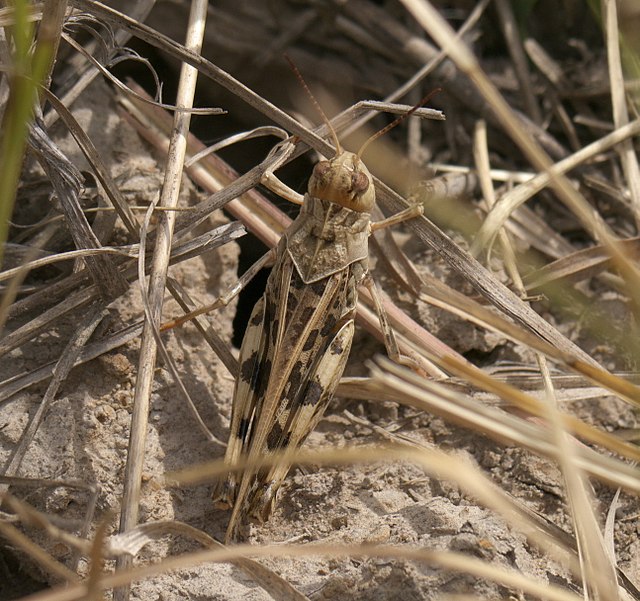
The female wrinkled grasshopper (Hippiscus ocelote) can grow to 53mm, while males grow to 40mm. These are heavy-bodied grasshoppers with a rounded head and irregularly raised parallel ridges near the rear.
They are brown or gray with an X mark on the pronotum and orange, pink, yellow, or red legs with a dark curved band. The tip of the wing is clear. They prefer grasslands, meadows, and pastures with short and dry grass.
You are likely to encounter the wrinkled grasshopper from July to October.
17. Red-legged Grasshopper

Red-legged grasshoppers (Melanoplus femurrubrum) that feed on crops. They fly in swarms and can decimate a field quickly. They are known to destroy barley, wheat, alfalfa, and soybean crops.
They are also known to carry immature tapeworm and bird parasites. The grasshoppers are not easy to control. This medium-sized grasshopper can grow to 3cm for females and 2.4cm for males.
The red-legged grasshopper can be identified by its red/brown back, green/yellow belly, and red hind tibia.
18. Showy Grasshopper

The showy grasshopper (Hesperotettix speciosus) is a bright green grasshopper with spotted white eyes and a mottle of white on the body. There is usually a pink/purple line down the back and on the legs.
They are common in old fields, roadsides, and field margins where they feed on sunflowers and other flowers.
19. Snakeweed Grasshopper

Snakeweed grasshoppers (Hesperotettix viridis) are colorful green grasshoppers with black, white, or cream markings with orange stripes. These medium-sized grasshoppers grow to 33mm in females and 22mm in males. They have narrow wings, reaching the tip of the abdomen.
20. Brown Winter Grasshopper

Brown winter grasshoppers (Amblytropidia mysteca) have slender bodies and long legs. They have elongated heads, sometimes in a cone shape with a slanted face. They can range from green to brown with short wings, which help them increase their jumping distance, though they cannot fly.
The male brown winter grasshopper can grow to 24mm, while females grow to around 30mm. They are yellow/brown in color with a golden stripe that runs along the top of their backs. They have large eyes and short antennae.
This grasshopper can be found throughout the year in grasses in pine woodlands.
21. Plains Yellow-winged Grasshopper
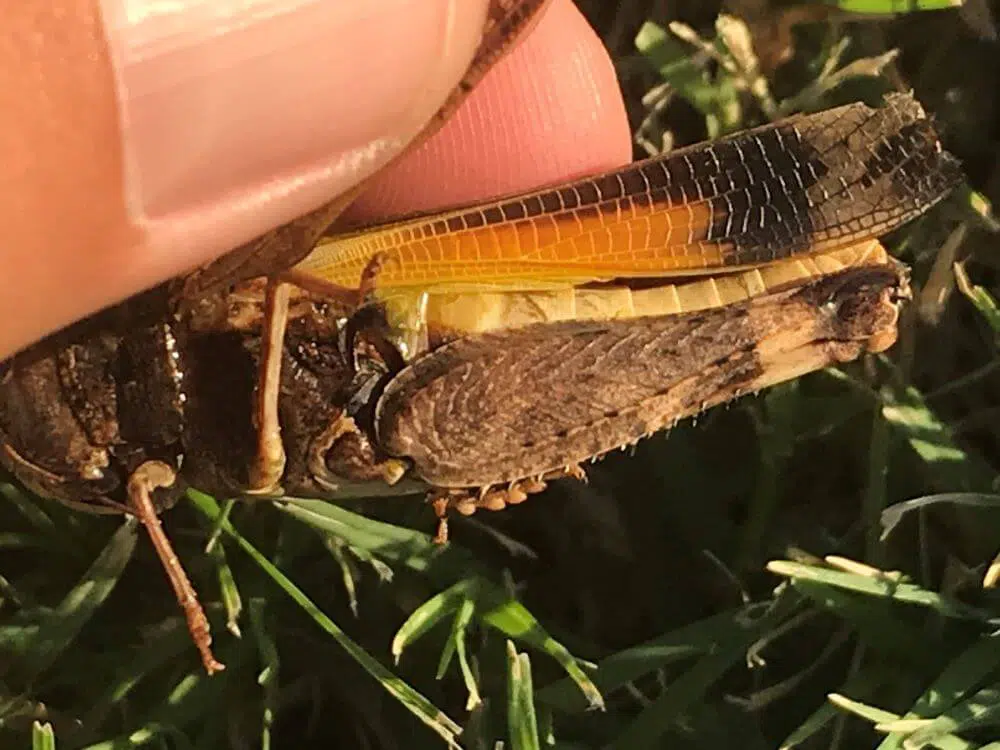
The plains yellow winged grasshopper (Arphia simplex) can grow to 55mm with females being larger than the male. They are the largest species of Arphia. They have yellow to orange colored hind wings and blue hind tibia.
They make a ticking to snapping sound when they fly, though females are known to fly without making a noise. These grasshoppers are most common in grasslands.
22. Montezuma’s Grasshopper

A female Montezuma’s grasshopper (Syrbula montezuma) can grow to 46mm with males growing to around 32mm. They have a striking pattern of brown and green, sometimes black. They also have black wings.
These grasshoppers are common in grasslands and anywhere where there is tall grass. They are mostly encountered from July to October as they feed on grasses.
23. Horse Lubber Grasshopper

The horse lubber grasshopper (Taeniopoda eques) is a huge grasshopper that has beautiful pink wings. They are larger than other grasshoppers and are not the usual brown color. They are a satin black with yellow banding and markings on their body.
They have bright pink wings, which warn off predatory birds. They use a foul odor and frothy substance from their thorax if they are threatened, deterring predators. The grasshopper will hiss if disturbed or snap their fore wings.
They are common in parks and fields, often seen in open developed areas.
24. Mexican Pygmy Grasshopper

The Mexican pygmy grasshopper (Paratettix mexicanus) is a very small and inconspicuous grasshopper found throughout Texas. These tiny grasshoppers only grow to 12.4mm and vary in coloration.
You may encounter these grasshoppers throughout the year in Texas.
25. Southern Green-striped Grasshopper

Southern green striped grasshoppers (Chortophaga australior) are often encountered in moist areas with short grass, such as hay meadows and roadsides. They grow to 30mm for males and 38mm for females.
26. Cattail Toothpick Grasshopper

The cattail toothpick grasshopper (Leptysma marginicollis) has a pointed head and sword-shaped antennae. They tend to be brown with a yellow, brown, or white stripe that runs from the eye to the base of the forelegs. They can range from red to pink on the top of their bodies.
These grasshoppers are common from April, where they are found in vegetations such as sedges and cattails. Males grow to 31mm and females to 38mm. These grasshoppers inhabit wet areas, with adults being more common in early spring.
27. Pine-tree Spur-throat Grasshopper

Pine tree spur-throated grasshoppers (Melanoplus punctulatus) can grow to 45mm in females and 31mm in males. They have a camouflage pattern with gray banding and bright red on their legs.
These grasshoppers prefer oak savannahs and forests. They are seen on the trunk of trees where they camouflage into their surroundings. They are often seen from July to November.
28. Mischievous Bird Grasshopper

One of the smallest of its family, the Mischievous bird grasshopper (Schistocerca damnifica) is still bigger than most of the other grasshoppers. They are mostly brown, though some have orange and red to their coloration.
Their wings grow with each molt and can fly. They are known as pests to crops and ornamental plants. Females can grow to 47mm and males to 35mm. They have a thick antenna.
They are common throughout the year in old fields and open woodlands.
29. Spotted-winged Grasshopper

The spotted winged grasshopper (Orphulella pelidna) is common in Texas and can be found in any open habitat with grass. These slender grasshoppers have fore wings that extend past the tip of their abdomen. They are usually brown or green in color.
They are known to become more black in color when on dark soil. Females can grow to 28mm and males to 25mm n body length. There is a strip from the back of the eye and over the lateral side of the pronotum.
30. Three-banded Grasshopper

The tree-banded grasshopper (Hadrotettix trifasciatus) is a large and robust insect that is dark gray to red/brown in color with bands on the fore wings and long antennae. They are not strong flyers, only traveling short distances.
They crepitate when flying, which s a clicking or snapping noise that their wings make. When at rest, stridulation occurs, where they rub their hind femur against their fore wing to attract a mate.
31. Fuzzy Olive-Green Grasshopper

The fuzzy olive-green grasshopper (Campylacantha olivacea) has a distinct color pattern with pale yellow veins. They are slender grasshoppers with long wings. They are common in the Gulf Coast of Texas where they prefer sunny grasslands, deserts, and shrublands.
32. Larger Pygmy Mole Grasshopper

The larger pygmy mole grasshopper (Neotridactylus apicialis) can grow to 10mm in body length and is different from other small sand grasshoppers. These grasshoppers have larger legs and are found near water in sandy habitats.
They can be found throughout the year where they feed n organic material, such as algae.
33. Aztec Grasshopper
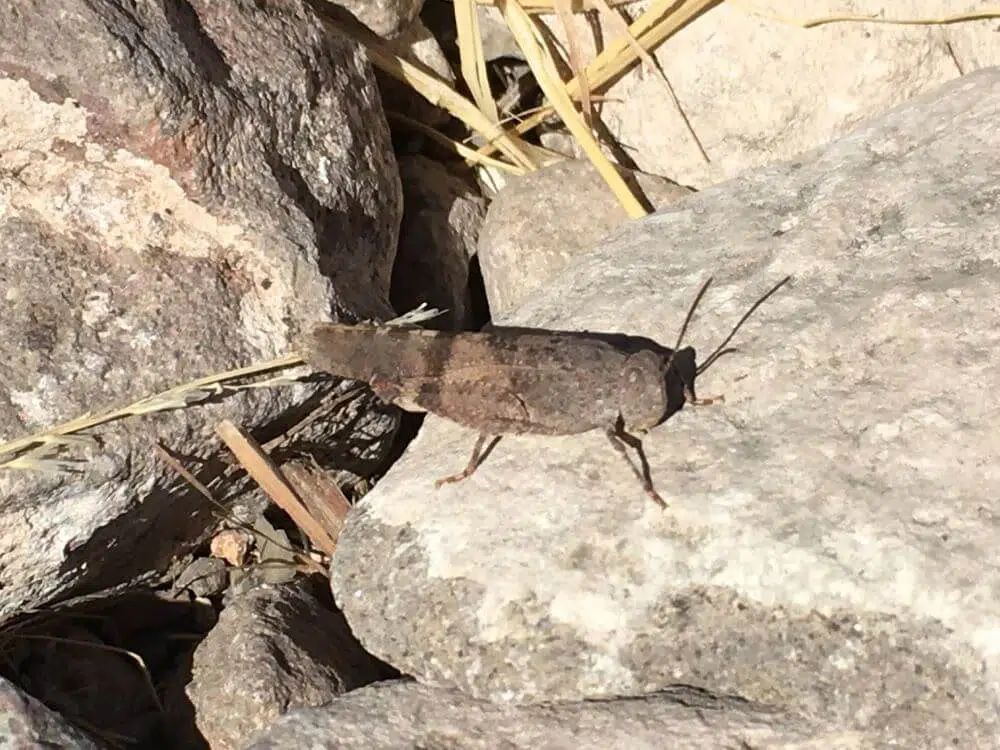
Aztec grasshoppers (Lactista azteca) are band-winged grasshoppers, common in North America. They belong to the subfamily yoedipodinea with a global distribution. They are often seen in weedy fields.
These grasshoppers can be identified by their colorful hind wings, which may be red or yellow with black edging. Some have pale edging.
34. Two-striped Grasshopper

The two striped grasshoppers (Melanoplus bivittatus) belong to the Melanoplus genus and are common in North America. They are a large species, which can grow to 55mm in body length.
There are two pale yellow stripes that run down the top of the body, from just above the eyes to the tip of the wings. Their body is yellow/green. They have enlarged hind legs to help with jumping and two pairs of wings, which overlap each other.
35. Seaside Grasshopper

This medium-sized grasshopper (Trimerotropis maritima) has a speckled pattern, helping it blend into the sand. They have yellow wings with a red hind tibia. They are loud and are known to crepitate when flying.
These grasshoppers prefer sandy areas, usually dunes and beaches. They are also found on sandy dirt roads and riverside sand bars.
36. Prairie Boopie
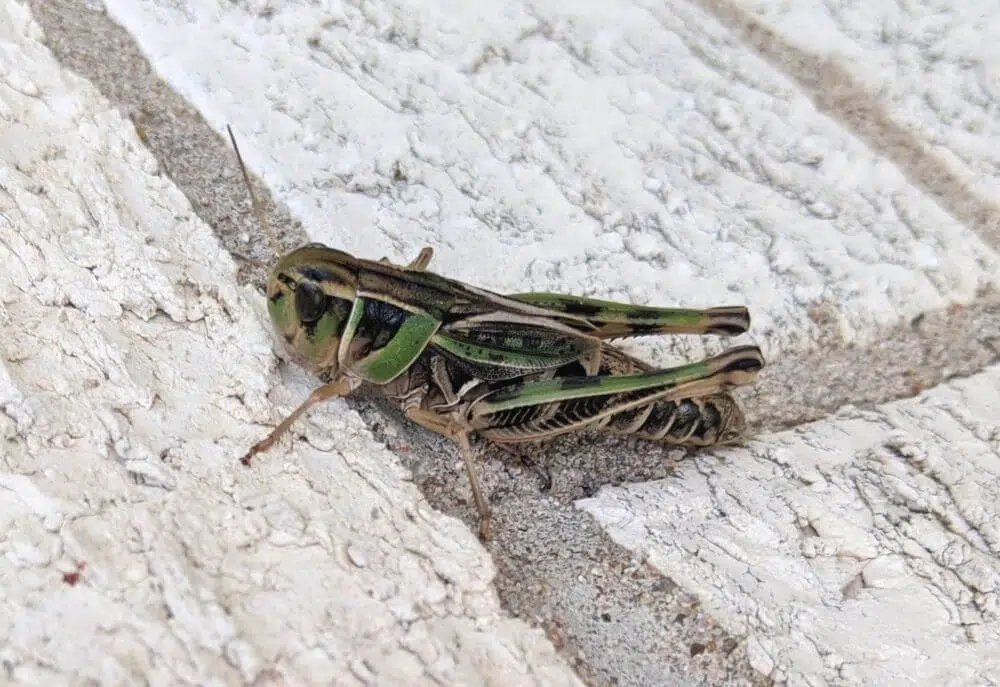
Males and female prairie boogie grasshoppers (Boopedon gracile) are very different. Males have a black and cream pattern with wings that extend past their abdomen. There is a cream band at the end of each abdominal segment.
Females have short wings, are large in size, and can vary from brown to green with black markings. They are usually encountered in dense grasses, which include savannahs, rangelands, and prairies. They are more abundant in overgrazed prairies.
37. Black-sided Pygmy Grasshopper

Black-sided pygmy grasshoppers (Tettigidea lateralis) belong to the Tetrigidae family and are common in Texas. Females can grow to 14mm with males being a bit smaller at 11mm. They can vary from black and gray to brown or cream. They are usually black-sided with a cream band on the top.
They are found in wet and dry habitats from coniferous forests to deciduous forests, sand dunes, and swamps.
38. Migratory Grasshopper

The migratory grasshopper (Melanoplus sanguinipes) is a spur-throated grasshopper that belongs to the Acrididae family. They are similar to many of the other species, making it hard to identify them.
Their preferred habitat is open sunny areas with herbaceous plant cover.
39. Southwestern Dusky Grasshopper

It is not easy to separate the southwestern dusky grasshopper (Nebulatettix subgracilis) from other grasshoppers. These are stocky grasshoppers with large heads and short wings.
They can be found in a variety of habitats where water collects for a short period. They favor grasses and are often seen on patchy and short grass.
40. Atlantic Grasshopper
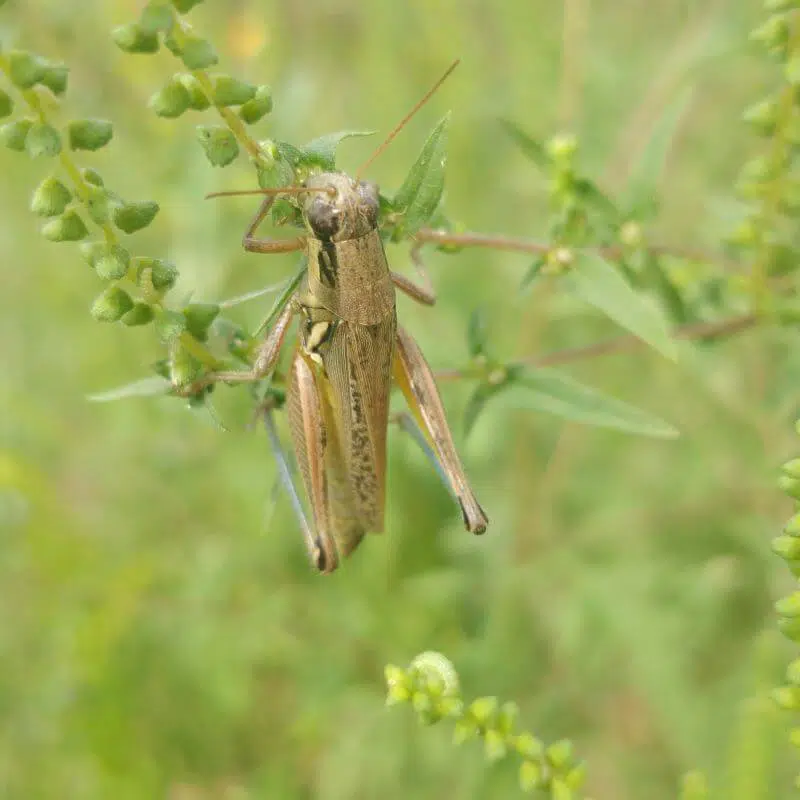
The Atlantic grasshopper (Paroxya atlantica) can grow to 28mm in females and 24mm in males. They are a yellow/brown color with red on the upper side and a dark stripe just behind the eye. Their legs are a green color with black on the lower side of the thorax and short antennae.
These grasshoppers prefer moist and grassy areas, with plenty of low shrubby vegetation. They can often be seen on the edge of marshes, forests, and woodlands. They tend to prefer areas with sandy soils. You are more likely to encounter this grasshopper from July to October.
Further Reading: